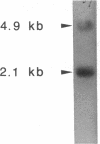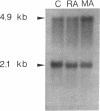Abstract
The mammalian proximal tubule is an important mediator of the renal adaptive response to systemic acidosis. In chronic metabolic and respiratory acidosis the bicarbonate reabsorptive (or proton secretory) capacity is increased. This increase is mediated, at least in part, by an increase in Vmax of the luminal Na/H antiporter. To determine whether this adaptation involves increased mRNA expression, Na/H antiporter mRNA levels were measured by Northern analysis in renal cortex of rats with metabolic (6 mmol/kg body wt NH4Cl for 2 or 5 d) and respiratory (10% CO2/air balanced for 2 or 5 d) acidosis and of normal, pair-fed rats. Na/H antiporter mRNA levels were unchanged after 2 d of both metabolic and respiratory acidosis. After 5 d, however, Na/H antiporter mRNA expression was increased 1.76 +/- 0.12-fold in response to metabolic acidosis (P less than 0.005, n = 8), but was not different from normal in response to respiratory acidosis: 1.1 +/- 0.2 (NS, n = 8). Thus, the renal adaptive response to metabolic acidosis involves increased cortical Na/H antiporter mRNA levels. In contrast, the enhanced proximal tubule Na/H antiporter activity and bicarbonate reabsorption in respiratory acidosis seem to involve mechanisms other than increased Na/H antiporter gene expression.
Full text
PDF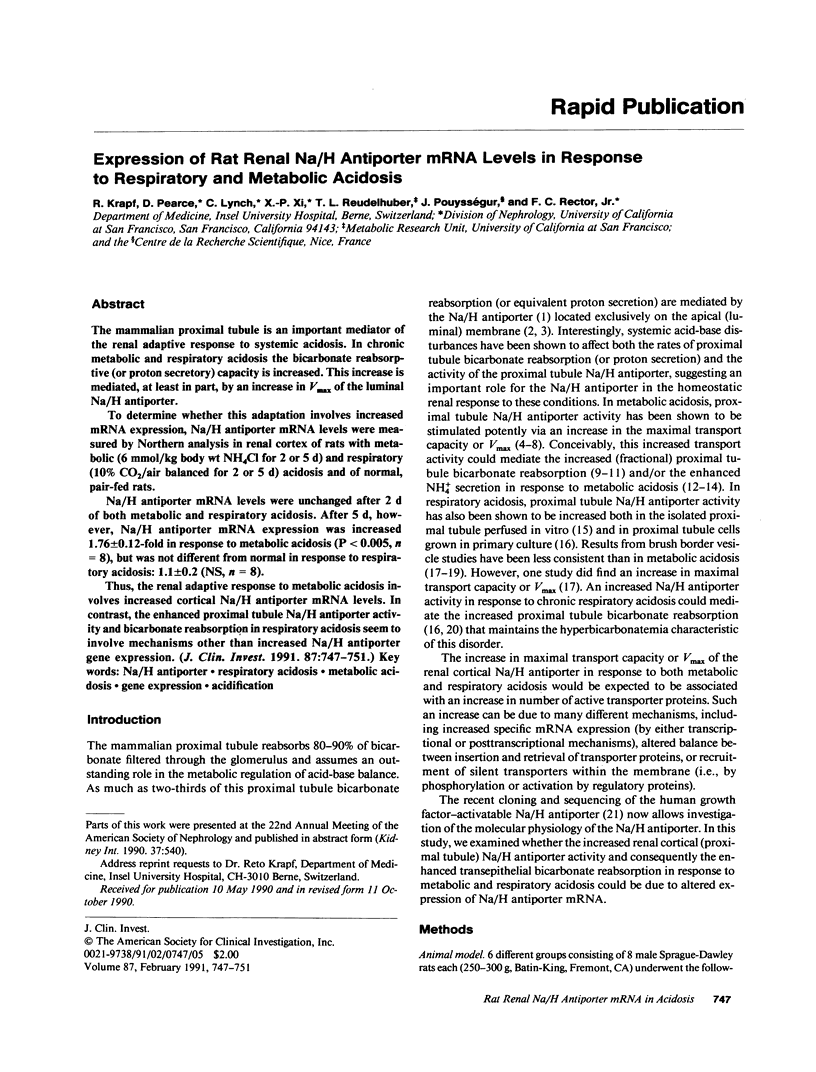
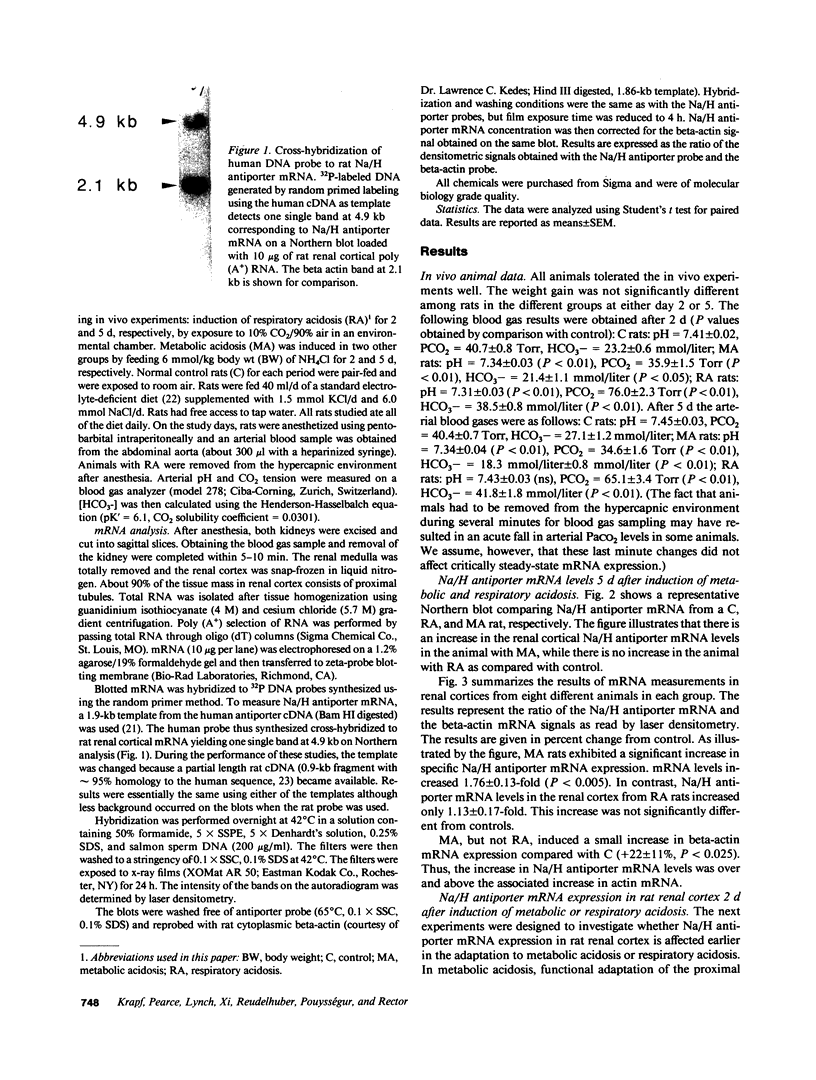
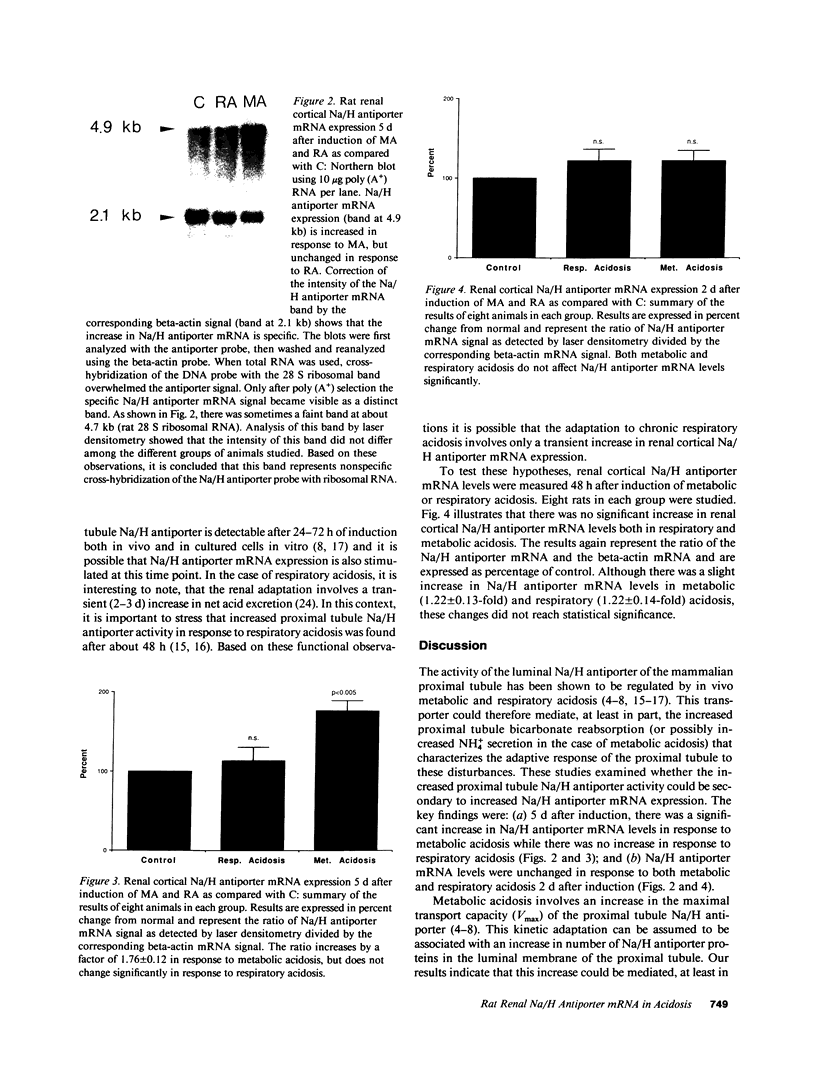
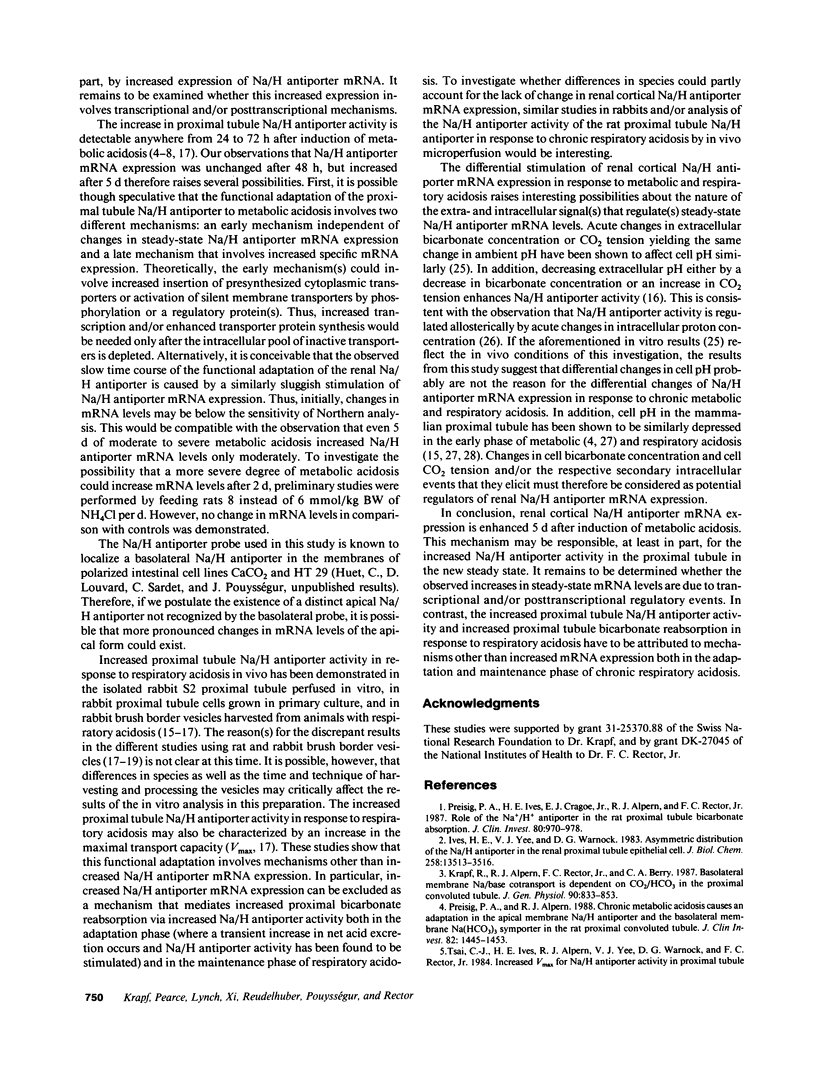
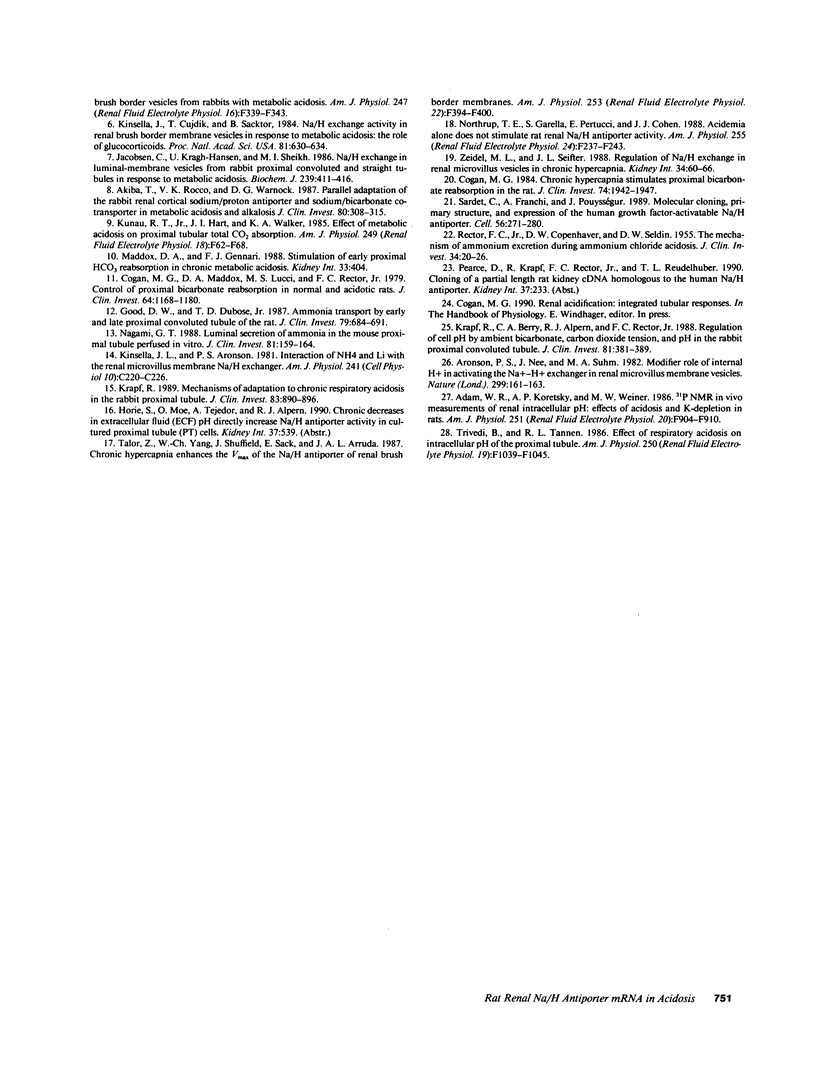
Images in this article
Selected References
These references are in PubMed. This may not be the complete list of references from this article.
- Adam W. R., Koretsky A. P., Weiner M. W. 31P-NMR in vivo measurement of renal intracellular pH: effects of acidosis and K+ depletion in rats. Am J Physiol. 1986 Nov;251(5 Pt 2):F904–F910. doi: 10.1152/ajprenal.1986.251.5.F904. [DOI] [PubMed] [Google Scholar]
- Akiba T., Rocco V. K., Warnock D. G. Parallel adaptation of the rabbit renal cortical sodium/proton antiporter and sodium/bicarbonate cotransporter in metabolic acidosis and alkalosis. J Clin Invest. 1987 Aug;80(2):308–315. doi: 10.1172/JCI113074. [DOI] [PMC free article] [PubMed] [Google Scholar]
- Aronson P. S., Nee J., Suhm M. A. Modifier role of internal H+ in activating the Na+-H+ exchanger in renal microvillus membrane vesicles. Nature. 1982 Sep 9;299(5879):161–163. doi: 10.1038/299161a0. [DOI] [PubMed] [Google Scholar]
- Cogan M. G. Chronic hypercapnia stimulates proximal bicarbonate reabsorption in the rat. J Clin Invest. 1984 Dec;74(6):1942–1947. doi: 10.1172/JCI111614. [DOI] [PMC free article] [PubMed] [Google Scholar]
- Cogan M. G., Maddox D. A., Lucci M. S., Rector F. C., Jr Control of proximal bicarbonate reabsorption in normal and acidotic rats. J Clin Invest. 1979 Nov;64(5):1168–1180. doi: 10.1172/JCI109570. [DOI] [PMC free article] [PubMed] [Google Scholar]
- Good D. W., DuBose T. D., Jr Ammonia transport by early and late proximal convoluted tubule of the rat. J Clin Invest. 1987 Mar;79(3):684–691. doi: 10.1172/JCI112871. [DOI] [PMC free article] [PubMed] [Google Scholar]
- Jacobsen C., Kragh-Hansen U., Sheikh M. I. Na+-H+ exchange in luminal-membrane vesicles from rabbit proximal convoluted and straight tubules in response to metabolic acidosis. Biochem J. 1986 Oct 15;239(2):411–416. doi: 10.1042/bj2390411. [DOI] [PMC free article] [PubMed] [Google Scholar]
- Kinsella J. L., Aronson P. S. Interaction of NH4+ and Li+ with the renal microvillus membrane Na+-H+ exchanger. Am J Physiol. 1981 Nov;241(5):C220–C226. doi: 10.1152/ajpcell.1981.241.5.C220. [DOI] [PubMed] [Google Scholar]
- Kinsella J., Cujdik T., Sacktor B. Na+-H+ exchange activity in renal brush border membrane vesicles in response to metabolic acidosis: The role of glucocorticoids. Proc Natl Acad Sci U S A. 1984 Jan;81(2):630–634. doi: 10.1073/pnas.81.2.630. [DOI] [PMC free article] [PubMed] [Google Scholar]
- Krapf R., Alpern R. J., Rector F. C., Jr, Berry C. A. Basolateral membrane Na/base cotransport is dependent on CO2/HCO3 in the proximal convoluted tubule. J Gen Physiol. 1987 Dec;90(6):833–853. doi: 10.1085/jgp.90.6.833. [DOI] [PMC free article] [PubMed] [Google Scholar]
- Krapf R., Berry C. A., Alpern R. J., Rector F. C., Jr Regulation of cell pH by ambient bicarbonate, carbon dioxide tension, and pH in the rabbit proximal convoluted tubule. J Clin Invest. 1988 Feb;81(2):381–389. doi: 10.1172/JCI113330. [DOI] [PMC free article] [PubMed] [Google Scholar]
- Krapf R. Mechanisms of adaptation to chronic respiratory acidosis in the rabbit proximal tubule. J Clin Invest. 1989 Mar;83(3):890–896. doi: 10.1172/JCI113973. [DOI] [PMC free article] [PubMed] [Google Scholar]
- Kunau R. T., Jr, Hart J. I., Walker K. A. Effect of metabolic acidosis on proximal tubular total CO2 absorption. Am J Physiol. 1985 Jul;249(1 Pt 2):F62–F68. doi: 10.1152/ajprenal.1985.249.1.F62. [DOI] [PubMed] [Google Scholar]
- Nagami G. T. Luminal secretion of ammonia in the mouse proximal tubule perfused in vitro. J Clin Invest. 1988 Jan;81(1):159–164. doi: 10.1172/JCI113287. [DOI] [PMC free article] [PubMed] [Google Scholar]
- Northrup T. E., Garella S., Perticucci E., Cohen J. J. Acidemia alone does not stimulate rat renal Na+-H+ antiporter activity. Am J Physiol. 1988 Aug;255(2 Pt 2):F237–F243. doi: 10.1152/ajprenal.1988.255.2.F237. [DOI] [PubMed] [Google Scholar]
- Preisig P. A., Alpern R. J. Chronic metabolic acidosis causes an adaptation in the apical membrane Na/H antiporter and basolateral membrane Na(HCO3)3 symporter in the rat proximal convoluted tubule. J Clin Invest. 1988 Oct;82(4):1445–1453. doi: 10.1172/JCI113750. [DOI] [PMC free article] [PubMed] [Google Scholar]
- Preisig P. A., Ives H. E., Cragoe E. J., Jr, Alpern R. J., Rector F. C., Jr Role of the Na+/H+ antiporter in rat proximal tubule bicarbonate absorption. J Clin Invest. 1987 Oct;80(4):970–978. doi: 10.1172/JCI113190. [DOI] [PMC free article] [PubMed] [Google Scholar]
- RECTOR F. C., Jr, SELDIN D. W., COPENHAVER J. H. The mechanism of ammonia excretion during ammonium chloride acidosis. J Clin Invest. 1955 Jan;34(1):20–26. doi: 10.1172/JCI103058. [DOI] [PMC free article] [PubMed] [Google Scholar]
- Sardet C., Franchi A., Pouysségur J. Molecular cloning, primary structure, and expression of the human growth factor-activatable Na+/H+ antiporter. Cell. 1989 Jan 27;56(2):271–280. doi: 10.1016/0092-8674(89)90901-x. [DOI] [PubMed] [Google Scholar]
- Talor Z., Yang W. C., Shuffield J., Sack E., Arruda J. A. Chronic hypercapnia enhances Vmax of Na-H antiporter of renal brush-border membranes. Am J Physiol. 1987 Sep;253(3 Pt 2):F394–F400. doi: 10.1152/ajprenal.1987.253.3.F394. [DOI] [PubMed] [Google Scholar]
- Trivedi B., Tannen R. L. Effect of respiratory acidosis on intracellular pH of the proximal tubule. Am J Physiol. 1986 Jun;250(6 Pt 2):F1039–F1045. doi: 10.1152/ajprenal.1986.250.6.F1039. [DOI] [PubMed] [Google Scholar]
- Tsai C. J., Ives H. E., Alpern R. J., Yee V. J., Warnock D. G., Rector F. C., Jr Increased Vmax for Na+/H+ antiporter activity in proximal tubule brush border vesicles from rabbits with metabolic acidosis. Am J Physiol. 1984 Aug;247(2 Pt 2):F339–F343. doi: 10.1152/ajprenal.1984.247.2.F339. [DOI] [PubMed] [Google Scholar]
- Zeidel M. L., Seifter J. L. Regulation of Na/H exchange in renal microvillus vesicles in chronic hypercapnia. Kidney Int. 1988 Jul;34(1):60–66. doi: 10.1038/ki.1988.145. [DOI] [PubMed] [Google Scholar]



